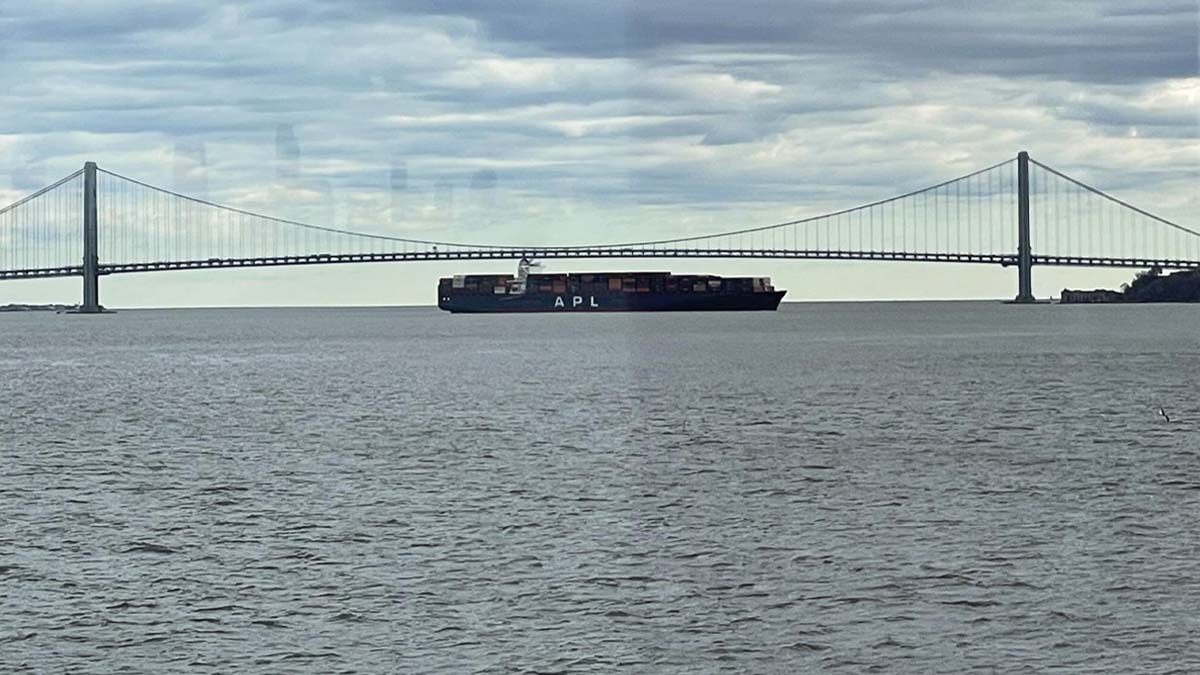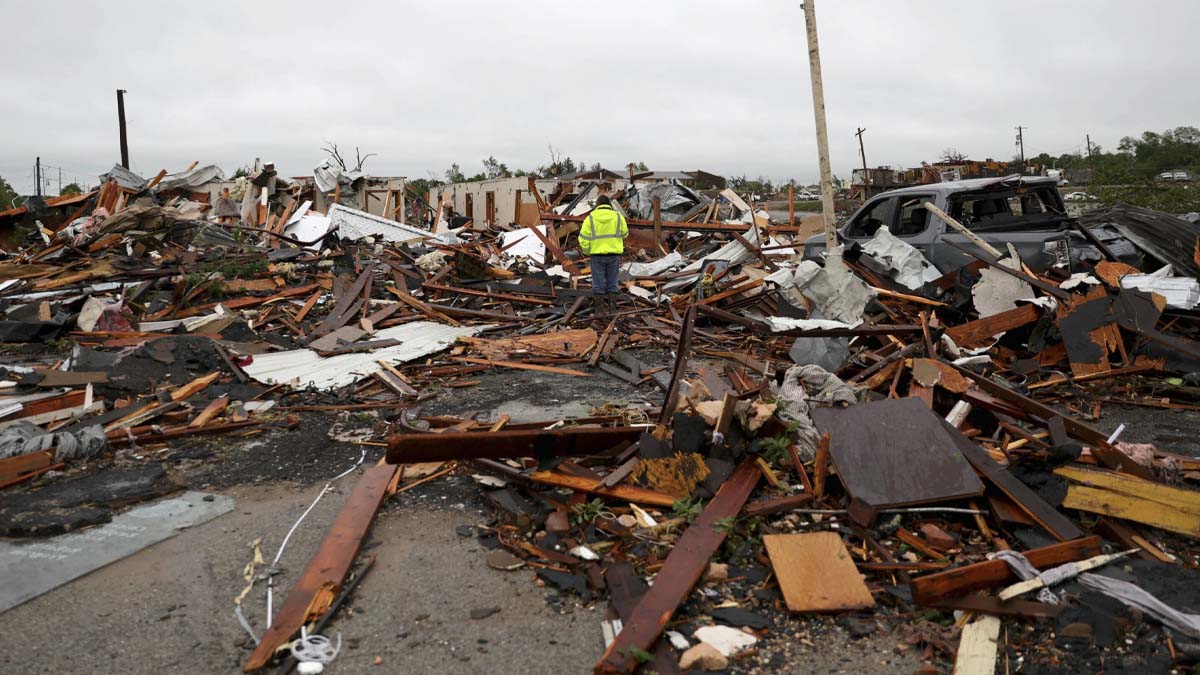
Massive Container Ship Loses Power Near NYC Bridge
-


Islamist Extremists Attack & Burn Christian Homes in Egypt
-


OnlyFans Creator Claims She Was Paid to Spread ‘Political Propaganda’ for Biden Admin
-


WATCH: 13-Year-Old Girl Allegedly Mobbed by Parents, Beaten by Student at NY High School
-


Biden Tries to Downplay Age with Jokes, Mocks Trump at White House Correspondents Dinner
A massive container ship lost power in the waters around New York City and was brought to a rest near the Verrazzano-Narrows Bridge Friday night — less than two weeks after failure on another massive cargo vessel caused it to smash into Baltimore’s Francis Scott Key Bridge.
The US Coast Guard confirmed that its Vessel Traffic Service received a report that the 89,000-ton M/V Qingdao lost propulsion about 8:30 p.m. as it traversed Kill Van Kull waterway — the shipping lane between Staten Island and Bayonne, New Jersey.
An image shared on X by John Konrad, CEO of maritime-focused news outlet gCaptain, shows the 1,100-foot Qingdao floating uncomfortably close to the span that connects Brooklyn and Staten Island.
BREAKING: A NY tugboat captain has reported to @gCaptain “container ship APL QINGDAO lost power while transiting New York harbor. They had 3 escort tugs but 3 more were needed to bring her under control. They regained power & were brought to anchor near the verrazano bridge” pic.twitter.com/Z2IP04xmLs
— John Ʌ Konrad V (@johnkonrad) April 7, 2024
In response to the power failure, three tug boats were dispatched to bring the Qingdao under control.
The vessel was reportedly positioned “just north” of the bridge.
“Coast Guard Vessel Traffic Service New York received a report from the M/V Qingdao around 8:30pm, Saturday, that the vessel had experienced a loss of propulsion in the Kill Van Kull waterway,” a Coast Guard spokesperson told The Post in a statement Sunday.
“The vessel regained propulsion and was assisted to Stapleton Anchorage by tugs.”
The Kill Van Kull waterway is a narrow 3-mile long tidal strait separating Newark Bay — home to the Port Newark Container Terminal — and Upper New York Bay. It is one of the Port of New York and New Jersey’s busiest waterways.
The Coast Guard required the vessel’s propulsion system to be certified that it had been repaired and was fully operational.
The crew was also required to provide a detailed casualty report documenting precisely what contributed to the loss of propulsion.
After meeting those requirements, the vessel was allowed to resume its voyage to Charleston, South Carolina.
Despite the unsettling optical illusion, the image instantly brings to mind last month’s deadly Francis Scott Key Bridge disaster in Baltimore, in which six construction workers were killed when cargo ship Dali rammed one of the 1.9-mile bridge’s supports, sending it tumbling into the Patapsco River.
The collapse ground maritime transit to a halt in the vital Port of Baltimore. Speaking on CBS’ “Face the Nation” Sunday morning, Maryland Gov. Wes Moore said it was “realistic” that normal operations would resume on the waterway as early as May.
“It is an aggressive timeline, but we are going to work around the clock to make sure we hit this timeline,” Moore said.
Alarmingly, the Dali also suffered loss of propulsion leading up to the Baltimore crash.
The Qingdao is registered in Malta and owned by French shipping and logistics company CMA CGM. It was bound for Norfolk, Virginia at the time it lost power.

News
Hunter Biden Threatens Lawsuit Against Fox News

Hunter Biden’s legal team reportedly sent a letter threatening to sue Fox News “imminently” over the alleged “unlicensed commercial exploitation” of the president’s son.
Mark Geragos, an attorney for the younger Biden, warned Fox Corporation and Fox News Digital of their preparation to seek damages over the network’s alleged “conspiracy and subsequent actions to defame [Hunter] Biden and paint him in a false light, the unlicensed commercial exploitation of his image, name, and likeness, and the unlawful publication of hacked intimate images of him,” according to NBC News. No lawsuit has currently been filed.
The April 23 letter is signed by Tina Glandian, a partner at the Geragos and Geragos law firm working on the case, according to NBC News. The firm gave Fox News until April 26 to respond, though the network has reportedly not responded.
The younger Biden’s legal team has reportedly been planning to sue Fox for over a year, according to NBC News. Geragos said the network “relentlessly attacked” his client for good ratings and “financial gain.”
“For the last five years, Fox News has relentlessly attacked Hunter Biden and made him a caricature in order to boost ratings and for its financial gain,” Geragos said in a statement. “The recent indictment of FBI informant Smirnov has exposed the conspiracy of disinformation that has been fueled by Fox, enabled by their paid agents and monetized by the Fox enterprise. We plan on holding them accountable.”
The letter mentions Fox News’ coverage of the Biden bribery allegations raised by Alexander Smirnov, who told the FBI that executives at Burisma—a Ukrainian energy company—discussed paying millions of dollars to Hunter and his father in order for the elder Biden to use his political clout to protect the company, NBC reported. The FBI charged Smirnov for allegedly fabricating the story about then-Vice President Joe Biden and Burisma, where Hunter served on the Board of Directors from 2014 to 2019.
The letter accused Fox News of intentionally labeling the allegations as “highly credible” despite the information being unverified, the outlet reported.
The letter demanded retractions and corrections from several anchors, including Sean Hannity, Maria Bartiromo and Jesse Watters, who the legal team said participated in this practice while covering the Smirnov allegations, according to the outlet.
The network is also accused of airing “intimate images” that were “hacked, stolen, and/or manipulated,” according to NBC News. The letter said many of these images were published during the six-part “mock trial” titled “The Trial of Hunter Biden” that aired in October 2021. Hunter’s legal team is demanding the “mock trial” series be removed from all streaming services.
“While using certain true information, the series intentionally manipulates the facts, distorts the truth, narrates happenings out of context, and invents dialogue intended to entertain. Thus, the viewer of the series cannot decipher what is fact and what is fiction,” the letter reportedly reads.
The letter is reportedly the second form of communication by Hunter’s legal team to Fox News this month, as they allegedly hand-delivered a previous letter to the network weeks ago, according to NBC News. Fox’s legal counsel reportedly asked for more time to give a response.
Hunter is charged with three counts of illegally purchasing a Colt Cobra revolver in October 2018 while under the influence of drugs. He is charged in a separate indictment with nine counts related to his failure to pay over $1 million in taxes over a four-year period.
News
3 US Marshals Dead, Officers Wounded in Shooting Near Charlotte — One Suspect Dead, 2 Others Detained

Three US Marshals were killed Monday and five other officers wounded when they were met with a hail of bullets while trying to serve a warrant in Charlotte, North Carolina.
Charlotte-Mecklenburg Police Department Chief Johnny Jennings said Tuesday called it the bloodiest day for law enforcement he’s seen in his 32 years on the job.
“Today we lost some heroes that were out there simply trying to keep our communities safe,” Jennings said at a press conference shortly after the situation settled.
“To me it’s the most tragic [day] that I’ve been involved in,” he added.
Gunfire broke out around 1:30 p.m. in a tree-lined residential street about 20 minutes west of downtown Charlotte as officers attempted to serve a warrant for a convicted felon in possession of a firearm.
Upon arriving at a home on Galway Drive, bullets started flying from within the house prompting the US Marshals to return fire.
When the gun smoke cleared, the suspect — the subject of the warrant — was dead on the front lawn, cops said. When officers approached the home again, more fire erupted from within, they said.
SWAT teams and patrol units from CMPD arrived to assist and were eventually able to clear the home, securing two other suspects in the process. There was at least one juvenile in the home, CMPD said.
It is unclear at what point during the violent exchange the officers were killed.
In addition to the fatalities, one US Marshal was wounded, as were four CMPD officers. One of the city police officers remains in critical condition. Their injuries vary from serious gunshots to graze wounds.
Exactly how many guns or what kind were involved remained unclear, but Jennings said one of the shooters opened fire with a “high-powered rifle.”
“They lost their lives after they gave us the opportunity to be in safe place,” said Charlotte Mayor Vi Lyles, fighting back tears.
“The most I can ask of our community is that we honor and respect them for all the work that they’ve done, for all the work that we’ll do, to make it possible for our city to be safer.”
News
Netanyahu Tells Biden He’s Worried About Possible ICC Arrest Warrants

Israeli Prime Minister Benjamin Netanyahu asked President Biden Sunday to help prevent the International Criminal Court from issuing arrest warrants for senior Israeli officials in connection with the war in Gaza, two Israeli officials told Axios.
Israeli officials have grown increasingly concerned over the last two weeks that the ICC is preparing to issue arrest warrants for Netanyahu, Defense Minister Yoav Gallant and Israel Defense Forces chief of staff Herzi Halevi.
The officials said Netanyahu expressed his concern to Biden in a phone call on Sunday, where the two leaders also discussed hostage negotiations, Israel’s defense against Iran’s missile attack, and the need to increase humanitarian aid to Gaza, according to a White House readout.
The ICC, which is based in The Hague, Netherlands, has been investigating possible war crimes by both Israeli forces and Palestinian militants dating back to the 2014 Israel-Hamas war.
U.S. officials said they do not have a clear indication whether the ICC is going to issue arrest warrants, but said the prosecutor’s office is under pressure from NGOs and several ICC member states to do so.
“Under my leadership, Israel will never accept any attempt by the ICC to undermine its inherent right of self-defense,” Netanyahu said in a statement on X Friday.
“While the ICC will not affect Israel’s actions, it would set a dangerous precedent that threatens the soldiers and officials of all democracies fighting savage terrorism and wanton aggression,” he added.
A spokesperson for the White House National Security Council declined to comment on the contents of Netanyahu’s call with Biden, but told Axios: “As we have publicly said many times, the ICC has no jurisdiction in this situation and we do not support its investigation.”
In March 2023, the ICC issued an arrest warrant for Russian President Vladimir Putin over his alleged involvement in the abduction of Ukrainian children and teenagers.
The International Court of Justice, a separate body also located in The Hague, is hearing a case brought by South Africa that alleges Israel is committing genocide with its military campaign in Gaza.
Israel has denounced the case as “baseless,” and U.S. officials have defended Israel in proceedings at the ICJ.
News
Zelensky Reveals US and Ukraine Are Working on 10 Year Military Funding Agreement

Ukrainian President Volodymyr Zelensky revealed that the United States and Ukrainian governments are “working on a bilateral security agreement” that would result in sending additional monetary aid to Ukraine over the next ten years.
In a statement issued on Sunday, Zelensky noted he had spoken to House Minority Leader Hakeem Jeffries (D-NY) thanking “him and all the congressmen for their support” of Ukraine and for voting to send a $61 billion aid package out of a $95 billion foreign aid package.
Zelensky added that during his conversation with Jeffries, he had “emphasized the need for Patriot systems.”
This is not the first time Zelensky has begged for more American-made Patriot missile systems to be sent to Ukraine.
Currently, Ukraine has three Patriot systems, one from the U.S. and two reportedly from Germany, according to the Washington Post.
On Friday, Secretary of Defense Lloyd Austin revealed that the U.S. would be sending Ukraine more Patriot systems as part of an additional $6 billion foreign aid package.
“Also, our teams, Ukraine and the United States, are currently working on a bilateral security agreement, and we are already working on a specific text. Our goal is to make this agreement the strongest of all. We are discussing the specific foundations of our security and cooperation,” Zelensky said.
“We are also working on fixing specific levels of support for this year and for the next ten years, including armed support, financial, political, and joint arms production.”
“The agreement should be truly exemplary and reflect the strength of American leadership. I am grateful to both our team and the team of the American side for the progress in drafting the agreement.”
On top of the $61 billion in foreign aid recently approved by the United States, United Kingdom Prime Minister Rishi Sunak vowed to send an additional £500 million in foreign aid to Ukraine.
News
Two Ex-NY Quarterbacks Out at CBS in Huge NFL Shakeup

CBS is benching a pair of former New York quarterbacks.
Boomer Esiason and Phil Simms are out at the “The NFL Today” as the NFL studio show undergoes a huge makeover with Matt Ryan and JJ Watt joining James Brown, Nate Burleson and Bill Cowher.
The former Jets quarterback announced on Monday morning that he is “stepping away” from the position and that he signed a long-term deal to remain with WFAN as co-host of their morning show with Gregg Giannotti.
“More their decision than maybe mine,” Esiason, 63, said of CBS before thanking all the behind-the-scenes staff that made his job possible.
“I had been there for 22 years. The guy who hired me back in 2001 was a guy by the name of Sean McManus, who was the CBS Sports Chairman… I never in my wildest dreams it would have lasted 22 years. With all the people that I’ve worked with CBS and the ‘NFL Today’ it’s been an amazing run.”
Watch:
Boomer Esiason announces he is leaving The NFL Today on CBS, but signed an extension to continue his WFAN morning show with Gio pic.twitter.com/91E0OzmGx9
— Awful Announcing (@awfulannouncing) April 29, 2024
McManus is stepping down from his role as chairman this year.
Simms, who helped the Giants win two Super Bowls, announced the news on X.
“Great 26 yrs run with CBS SPORTS. Even though that part of my career is over I look forward to what is next..,” Simms wrote.
The Post reported in January that changes could be coming with Esiason, Simms, Cowher and Brown all at the end of their contracts.
Simms was previously part of the No. 1 broadcasting booth alongside Jim Nantz before being replaced by Tony Romo in 2017.
Simms, 68, said in January that even if his time at CBS ends, he still plans on working in football broadcasting.
“I’m never going to get out of it,” Simms told The Post. “I don’t know what I’ll do if I don’t go back to CBS. But I’m definitely going to continue to work with or in the NFL — somewhere, somehow, whatever it is. I’m just not going to go, ‘OK, I’m done. I’m retired.’ ”
Brown, the show’s longtime host, was expected to get a new deal with his contract up.
News
Islamist Extremists Attack & Burn Christian Homes in Egypt

Islamist extremists reportedly set fire to several Christian houses and businesses in southern Egypt last week.
The violence broke out on Tuesday night in the village of Al-Fawakher, which is home to about 3,000 Christian families. The local Christian community had recently received a permit to construct a new church building, prompting backlash from some Muslim hardliners.
“The attacks are believed to have been triggered by an attempt to build a new church in Al-Fawakher village in Minya [province],” one local source, who asked to remain anonymous, told The New Arab. “When religious fanatics failed to expel Christians from their homes as a form of punishment, the extremists [reportedly] burned down their houses while they were still inside.”
Mobs are out on the streets and burning down homes of Egyptian Coptic Christians in Al-Fawakher in Minya, Egypt. Beside the widespread antisemitism we see in the world there is also sadly a lot of christian persecution happening.
pic.twitter.com/HcTLO2wffR— Brian BJ (@iamBrianBJ) April 24, 2024
Video circulating on social media appears to show crowds of people dancing and celebrating in front of the burning buildings.
“The extremists attacked Coptic homes with stones and chants, and a number of homes were set on fire, amid the screams of women and children,” Copts United, a religious advocacy group, reported. “The attack continued for a long time before the security forces arrived.”
“Security forces arrived and brought the situation under control, arresting the instigators and perpetrators,” Coptic Bishop Anba Macarius said in a public statement on Wednesday: “State agencies will compensate those affected and hold the perpetrators accountable.Calm prevails in the village now. May God protect our dear country, Egypt, from all harm.”
Christians have long been a persecuted minority in Egypt. Conversion from Islam to Christianity is illegal and Christians are barred from holding certain public offices, and terror attacks against churches and religious minorities are fairly common. Minya province in particular has been a hotbed of violence, with at least 77 incidents recorded between 2011-2016, according to the Egyptian Initiative for Personal Rights.
According to Copts United, a similar attack took place on Friday in the village of Al-Kom Al-Ahmar, after a local Evangelical group was given permission to build a church there.
Bishop Macarius himself survived an assassination attempt in 2013.
The exact number of Christians within the country is contested, and the officially Islamic Egyptian government has been accused of trying to downplay the size of its Christian minority – estimates range anywhere from 5-15% of the country’s 111 million people, although it is generally agreed that the share is shrinking – likely as a result of conversion, migration, or lower fertility rates compared to Egypt’s Muslim majority.
The majority of Egypt’s Christians belong to the Coptic Orthodox Church, which claims descent from the Patriarchate of Alexandria, one of the 5 major centers of early Christianity, alongside Rome, Constantinople, Antioch and Jerusalem. The Coptic Church broke away from what would become the Catholic and Eastern Orthodox Churches in 451 AD after the Council of Chalcedon, over theological differences, and remained the dominant religion in Egypt until the country was conquered in 641 by Muhammed’s immediate successors in the Rashidun (“rightly guided”) Caliphate.
Egypt is also home to hundreds of thousands of Eastern Orthodox Christians, Protestants and Catholics.
“An unacceptable culture of intimidation and discrimination is still far too prevalent in this region despite positive steps taken by the Egyptian authorities in recent years, and the personal commitment of President Sisi to fight sectarian extremism and promote equality of citizenship,” Christian Solidarity Worldwide President Mervyn Thomas said in a press statement. “Egyptian citizens should all be free to practice any religion or belief of their choosing without fear of threats or physical violence.”
News
Humza Yousaf, Leader of Scotland, Resigns

Humza Yousaf, Scotland’s first minister, resigned on Monday after just 13 months in office following a series of muddled progressive policies that culminated in him torpedoing his own governing coalition.
Yousaf, who became the first Muslim leader of a Western democracy, stepped down on Monday after his decision to rip up an agreement between his Scottish National Party and the Green Party, known as the Bute House Agreement, cost him a working majority.
Scottish Green co-leader Lorna Slater said that Yousaf’s decision to stop the agreement was a “spectacular breach of trust.”
In the aftermath of Yousaf’s decision, a vote of no confidence was called for this week. And although he gave no indications he would resign last Friday, he changed his mind over the weekend.
“I’ve concluded that repairing our relationship across the political divide can only be done with someone else at the helm,” an emotional Yousaf said Monday during his resignation speech in Edinburgh, Scotland’s capital.
“I have therefore informed the SNP’s national secretary of my intention to stand down as party leader.”
Humza Yousaf confirms he is quitting as Scotland’s first minister, triggering leadership race
Follow live https://t.co/oRMyI5FLJ7 pic.twitter.com/mIr2ARmQVs
— BBC Breaking News (@BBCBreaking) April 29, 2024
Furthermore, he paid tribute to his family and said politics can be a “brutal business.”
Yousaf’s tenure as leader of the pro-independence party has included multiple obstacles and controversial policies.
He became leader of the SNP and first minister in March 2023 after longtime party leader Nicola Sturgeon stepped down. Her resignation came during a police investigation into alleged misuse of campaign funds. Her husband, former SNP treasurer Peter Murrell, was charged with embezzlement earlier this month, while Sturgeon herself was questioned and released without charge last year. Both deny any wrongdoing.
Yousaf’s short-lived tenure will be remembered, however, for controversial legislation that would make it easier for people to change their gender, which was at odds with the Conservative-led Westminster government.
His party also introduced a hate crime law that made transgender identity a protected characteristic. The law generated criticism from the likes of Harry Potter author J.K. Rowling, who lives in Edinburgh, and even X owner Elon Musk.
In the end, Yousaf’s tenure was made untenable after he scrapped the Bute deal with the Greens over climate change policy disagreements.
Douglas Ross, the leader of the Scottish Conservatives who tabled the motion of no confidence, told STV that Yousaf was “forced … out of office for repeatedly failing Scotland.”
He added: “There is no doubt that he wanted to continue as First Minister to continue with his reckless policies that have damaged Scotland.
“But facing a vote of no confidence brought forward by the Scottish Conservatives, he looked on course to be defeated and he has jumped before he was pushed.”
Anas Sarwar, the leader of the Scottish Labour Party, said: “The SNP are a divided party which is out of ideas and incapable of rising to the challenges Scotland faces.”
Keir Starmer, the leader of the United Kingdom’s Labour Party, told the BBC: “I despair of the situation in Scotland. It’s absolute chaos now from the Scottish Parliament from the SNP.”
Yousaf will stay on as leader until a successor can be elected. If the SNP cannot agree on a new leader within 28 days, an emergency general election will be triggered. The SNP has been the party of power in Scotland since 2007, sometimes in a coalition and sometimes with an outright majority.
News
OnlyFans Creator Claims She Was Paid to Spread ‘Political Propaganda’ for Biden Admin

An OnlyFans creator and TikTok star has claimed she was paid to spread “political propaganda” for the Biden administration on social media — and that she was asked to hide the fact it was advertising.
Farha Khalidi said she’d been asked to help boast about then-Judge Ketanji Brown Jackson to her tens of thousands of social media followers after Brown Jackson was nominated to the Supreme Court by President Biden.
“I was doing full-on political propaganda,” the social media personality said during a recent podcast interview with commentator Richard Hanania.
“The funny thing is they’re, like, ‘Do not disclose this as an ad’ because they [were], like, ‘Technically, it’s not a product, so you don’t have to disclose it’s an ad.’ Because I think they just wanted, like, some edgy girl of color to just tell people — like when they nominated Ketanji Brown Jackson, they’re, like, ‘Can you say “as a person of color,” you know, that you feel “reflected”?’”
When probed about the Biden admin, Khalidi, who boasts more than 119,000 Instagram followers, clarified that she was dealing with a “conduit” third-party media company at the time.
“It’s not Biden, but it’s, like, a third party. You know what I mean? It’s, like, a media company that’s doing it on his behalf. I’m not blaming him for this,” Khalidi said.
Farha Khalidi on how surrogates for the Biden administration tried to pay her to engage in identity politics and sell their message.
A case of racial division as a top-down phenomenon. They’re literally buying the TikTok influencers. pic.twitter.com/nJWGvsLlMu
— Richard Hanania (@RichardHanania) April 26, 2024
She went on to say that she ultimately pushed back against the “script” because it was a white woman from the media company telling her what to say.
“And I’m, like, ‘No,’ and she’s like, ‘Please,’ and I’m like, ‘No.’ I’ll talk about the news of it, but I’m not gonna be like — I’m not gonna have a white person tell me to be, like, ‘This is how I feel as a person of color.’ It’s just so — I think that black-pilled me slightly on political propaganda,” Khalidi said.
“Yeah, they’re basically, ‘As, like, another black person, can you just say that you feel reflected by Ketanji?’ I’m like, ‘No, I’ll talk about Ketanji’s background and her accomplishments,’ but you know what I mean? I’ll never — I’m not gonna say, like, the corny stuff, even if it was a brown person emailing it to me.”
Elsewhere in the interview, Khalidi said the political payments were just one way she was raking in cash during college.
“I was taking ads by the time I graduated college from, like, the Biden administration, Planned Parenthood and, like, dating apps and stuff. So it was, like, fully financially sustaining me,” Khalidi said.
It wasn’t immediately clear exactly how much Khalidi was paid.
News
DeSantis and Trump Meet Privately for Several Hours in Miami

Former President Trump and Florida Gov. Ron DeSantis met privately in Miami on Sunday, multiple Republicans with knowledge of the meeting confirmed to Fox News.
During the several-hour meeting, DeSantis agreed to help Trump as the GOP’s presumptive presidential nominee tries to close his fundraising gap with President Biden in their 2024 election rematch, the sources confirmed.
DeSantis, who was convincingly re-elected in 2022 before launching an unsuccessful bid for the 2024 Republican presidential nomination, has built up a formidable network of wealthy donors who could be helpful to Trump as the general election campaign heats up.
News of the meeting was first reported by the Washington Post, which said the get-together between the two rivals was orchestrated by Steve Witkoff, a Florida real estate broker known to both Trump and DeSantis.
Sources familiar confirmed to Fox News that the meeting was set up nearly 10 days ago, after DeSantis approached Witkoff.
The meeting appears to be the first time DeSantis and Trump have spoken, let alone met in person, since the governor ended his White House bid in January after a disappointing second-place finish in the Iowa caucuses, far behind Trump.
The former president and his allies spent nearly a year attacking DeSantis as the two squared off for the GOP nomination that also included other contenders.
DeSantis suspended his presidential campaign just two days ahead of the New Hampshire primary and has since endorsed Trump. But to date, DeSantis hasn’t campaigned on Trump’s behalf.
During a February call with supporters, the governor took aim at Trump and his top political advisers.
“I think he’s got people in his inner circle who were part of our orbit years ago that we fired, and I think some of that is they just have an ax to grind,” DeSantis said at the time.
In response, top Trump campaign aide Chris LaCivita called DeSantis a “sad little man.”
While many on Trump’s team and his wider political orbit detest DeSantis, the former president may be more forgiving if it benefits him.
Trump said in January after DeSantis endorsed him that he would “officially retire” the derogatory “Ron DeSanctimonious” nickname he used repeatedly to attack the Florida governor for nearly a year.
News
Oklahoma Tornadoes Kill 4; State of Emergency Issued

Tornadoes killed four people in Oklahoma and left thousands without power Sunday after a destructive outbreak of severe weather flattened buildings in the heart of one rural town and injured at least 100 people across the state.
More than 20,000 people remained without electricity after tornadoes began late Saturday night. The destruction was extensive in Sulphur, a town of about 5,000 people, where a tornado crumpled many downtown buildings, tossed cars and buses and sheared the roofs off houses across a 15-block radius.
“You just can’t believe the destruction,” Oklahoma Gov. Kevin Stitt said during a visit to the hard-hit town. “It seems like every business downtown has been destroyed.”
Stitt said about 30 people were injured alone in Sulphur, including some who were in a bar as the tornado struck. Hospitals across the state reported about 100 injuries, including people apparently cut or struck by debris or hurt from falls, according to the Oklahoma Department of Emergency Management.
White House officials said President Joe Biden spoke to Gov. Stitt on Sunday and offered the full support of the federal government.
The deadly weather in Oklahoma added to the dozens of reported tornadoes that wreaked havoc in the nation’s midsection since Friday. On Sunday, authorities in Iowa said a man injured during a tornado that hit the town of Minden on Friday had died, according to local reports.
Authorities said the tornado in Sulphur began in a city park before barreling through the downtown, flipping cars and ripping the roofs and walls off of brick buildings. Windows and doors were blown out of structures that remained standing.
“How do you rebuild it? This is complete devastation,” said Kelly Trussell, a lifelong Sulphur resident as she surveyed the damage. “It is crazy, you want to help but where do you start?”
Carolyn Goodman traveled to Sulphur from the nearby town of Ada in search of her former sister-in-law, who Goodman said was at a local bar before just before the tornado hit the area. Stitt said one of the victims was found inside a bar but authorities had not yet identified those killed.
“The bar was destroyed,” Goodman said. “I know they probably won’t find her alive … but I hope she is still alive.”
Farther north, a tornado near the town of Holdenville killed two people and damaged or destroyed more than a dozen homes, according to the Hughes County Emergency Medical Service. Another person was killed along Interstate 35 near the southern Oklahoma city of Marietta, state officials said.
Heavy rains that swept into Oklahoma with the tornadoes also caused dangerous flooding and water rescues. Outside Sulphur, rising lake levels shut down the Chickasaw National Recreation Area, where the storms wiped out a pedestrian bridge.
Stitt issued an executive order Sunday declaring a state of emergency in 12 counties due to the fallout from the severe weather.
At the Sulphur High School gym, where families took cover from the storm, Jackalyn Wright said she and her family heard what sounded like a helicopter as the tornado touched down over them.
Chad Smith, 43, said people ran into the gym as the wind picked up. The rain started coming faster and the doors slammed shut. “Just give me a beer and a lawn chair and I will sit outside and watch it,” Smith said. Instead, he took cover.
Residents in other states were also digging out from storm damage. A tornado in suburban Omaha, Nebraska, demolished homes and businesses Saturday as it moved for miles through farmland and into subdivisions, then slammed an Iowa town.
The tornado damage began Friday afternoon near Lincoln, Nebraska. An industrial building in Lancaster County was hit, causing it to collapse with 70 people inside. Several were trapped, but everyone was evacuated, and the three injuries were not life-threatening, authorities said.
One or possibly two tornadoes then spent around an hour creeping toward Omaha, leaving behind damage consistent with an EF3 twister, with winds of 135 to 165 mph (217 to 265 kph), said Chris Franks, a meteorologist in the National Weather Service’s Omaha office.
Nebraska Gov. Jim Pillen and Iowa Gov. Kim Reynolds spent Saturday touring the damage and arranging for assistance for the damaged communities. Formal damage assessments are still underway, but the states plan to seek federal help.
News
Half Arrested at UT-Austin Pro-Palestinian Protest Not Affiliated with School

Nearly half of the pro-Palestinian protesters arrested earlier this week at The University of Texas at Austin were not affiliated with the university.
Law enforcement officials arrested 57 protesters during Wednesday’s event organized by the Palestine Solidarity Committee after participants refused to disperse despite demands from authorities and the university. Of those arrested, 26 were neither students nor faculty of the university, according to officials at UT-Austin.
Hundreds of students walked out of class Wednesday in support of Palestinians in Gaza in the midst of the Israel-Hamas war. The war broke out after Palestinian terror group Hamas launched a brutal attack on Israel on Oct. 7, which left 1,200 Israelis dead. Hamas is believed to still be holding 129 hostages from Israel.
The organizers wrote on Instagram that they aimed to follow “in the footsteps of our comrades at Columbia SJP, Rutgers-New Brunswick, Yale, and countless others,” with SJP referring to Students for Justice in Palestine.
The anti-Israel student group demanded that the university “divest from death.”
“Consistent with this broader movement that is impacting so many, problematic aspects of the planned protest were modeled after a national organization’s protest playbook,” UT–Austin President Jay Hartzell said in a campuswide message Thursday evening. “And notably, 26 of the 55 individuals arrested yesterday had no UT affiliation.”
Local news outlet KTBC-TV reported that one of its photojournalists was among those arrested during the clash between police and protesters. He was booked into the Travis County jail on a criminal trespassing charge.
By Thursday evening, all of those arrested had been released. The Travis County prosecutor said it had dropped all criminal trespassing charges, citing “deficiencies” in charging documents. Criminal trespassing is considered a misdemeanor in the state of Texas.
According to the Texas Tribune, the Texas Department of Public Safety has opened a criminal investigation into the arrest of the photojournalist.
The UT–Austin chapter of the American Association of University of Professors denounced Mr. Hartzell for allowing authorities to be deployed on campus during the class walkout.
“We, faculty of UT Austin, condemn President Jay Hartzell and our administrative leaders’ decision to invite city police as well as state troopers from across the state—on horses, motorcycles, and bicycles, in riot gear and armed with batons, pepper spray, tear gas and guns to our campus today in response to a planned peaceful event by our students,” read the statement posted on X on Wednesday night.
Policy Violation
Ahead of Wednesday’s demonstration, university officials warned the organizers that the event violated school policy and would not be allowed to take place in an effort to prevent the “pattern” that has occurred across the nation in recent weeks, leading to hundreds of arrests.
“The University’s decision to not allow yesterday’s event to go as planned was made because we had credible indications that the event’s organizers, whether national or local, were trying to follow the pattern we see elsewhere, using the apparatus of free speech and expression to severely disrupt a campus for a long period,” Mr. Hartzell continued.
Palestine Solidarity Committee (PSC) is a student organization with chapters at colleges and universities across the country.
The group’s website states that it is “dedicated to telling the story of the Palestinian struggle for justice and self-determination on the university campus and in the wider Austin community. We work to promote education, discourse, activism, and awareness of the Palestinian story through lectures by academics and political activists, movie screenings, and events and displays on the UT West Mall.”
The UT–Austin group, which holds biweekly meetings on campus, states under Article 1 of its bylaws that it will comply with school policies.
“This organization is a recognized student organization at The University of Texas at Austin and shall comply with all campus policies as set forth in the Institutional Rules on Student Services and Activities and Information on Students’ Rights and Responsibilities,” it says.
UT Suspends Organization
The university suspended the student group from campus after another walkout on Thursday, which was organized in part by the faculty group that condemned the university for enforcing its rules.
Police were present during Thursday’s peaceful event.
“Students and faculty affirmed their commitment to continue struggling for the liberation of Palestine, to demand their university divest, and demand the resignation of President Jay Hartzell for greenlighting the militarized brutality enforced on students,” PSC wrote on Instagram.
PSC has held more than a dozen pro-Palestinian events since October.
“I’m thankful we live in a country where free expression is a fiercely protected Constitutional right,” Mr. Hartzell said in his campuswide message on Thursday. “I’m grateful that our campus has seen 13 pro-Palestinian events take place during the past several months largely without incident—plus another one today. I am grateful that everyone is safe after yesterday, we continue to hold in-person classes, and that today’s events followed our long-standing campus standards for allowed demonstrations.”
Brian Davis, a spokesperson for the university, confirmed on Friday that the student group had been suspended from campus in the wake of this week’s events. The length of the suspension is not immediately clear. Mr. Davis said that the Dean of Students office would make that determination.
It is unknown whether any students have been reprimanded for the events that occurred earlier this week. That information is protected by federal privacy laws.
“I encourage us all to continue to communicate and work together, and to help our students finish this school year in positive, safe and celebratory ways,” Mr. Hartzell said.
News
Dan Rather Makes Return to CBS, 18 Years After Bitter Departure

Dan Rather returned to the CBS News airwaves for the first time since his bitter exit 18 years ago, appearing in a reflective interview on “CBS Sunday Morning” days before the debut of a Netflix documentary on the 92-year-old newsman’s life.
After 44 years at the network, 24 as anchor of the “CBS Evening News,” Rather left under a cloud following a botched investigation into then-President George W. Bush’s military record. Rather signed off as anchor for the last time on March 9, 2005, and exited the network when his contract ended 15 months later.
With continued enmity between him and since-deposed CBS chief Leslie Moonves, Rather essentially became a nonperson at the news division he dominated for decades.
“Without apology or explanation, I miss CBS,” Rather told correspondent Lee Cowan in the interview that aired Sunday. “I’ve missed it since the day I left.”
Rather escaped official blame for the report that questioned Bush’s Vietnam War-era National Guard service but, as the anchor who introduced it, was identified with it. CBS could not vouch for the authenticity of some documents upon which the report was based, although many people involved in the story still believe it was true.
In the documentary “Rather,” debuting Wednesday on Netflix, Rather said he thought he would survive the incident, but his wife, Jean, told him, “You got into a fight with the president of the United States during his reelection campaign. What did you think was going to happen?”
Rather did not retire after leaving CBS, doing investigative journalism and rock star interviews for HDNet, a digital cable and satellite television network. Over the past few years, he has become known to a new generation as a tart-talking presence on social media.
This past week, he posted on X during former President Trump’s hush-money trial: “Is it just me or did today seem sleazy even for Donald Trump?”
“You either get engaged and you get engaged in the new terms … or you’re out of the game,” Rather said in the CBS interview, filmed at his home in Texas. “And I wanted to stay in the game.”
The Netflix documentary traces his career from coverage of President John F. Kennedy’s assassination, the Vietnam War and Watergate, through his anchor years and beyond. It includes some of the then tightly-wound Rather’s odder incidents, including an assault in New York City by someone saying, “What’s the frequency, Kenneth,” then later appearing onstage with R.E.M. when the group performed its song of the same name.
In both the documentary and in the CBS interview, Rather bypasses his career when talk turned to his legacy.
“In the end, whatever remains of one’s life — family, friends — those are going to be the things for which you’re remembered,” he said.
News
Russia Arrests More Journalists on ‘Extremism’ Charges

Three Russian journalists were arrested Friday and Saturday and detained, as Russia continues a crackdown on media inside the country.
Konstantin Gabov and Sergey Karelin were charged with “extremism” on Saturday, The Associated Press (AP) first reported. They stand accused of working with a political group associated with the late Russian opposition leader Alexei Navalny, who died earlier this year in prison.
The pair will be held in custody for at least two months before trial. The charges carry a sentence of two to six years in prison, if convicted.
Forbes Russia journalist Sergei Mingazov was also arrested Friday, his lawyer told the AP, on charges of spreading misinformation. Prosecutors said he was jailed for reporting about alleged Russian war crimes in the Ukrainian city of Bucha.
The three journalists jailed in recent days are all Russian citizens. Karelin holds dual Israeli citizenship, and previously worked as a cameraman for the AP and the German outlet Deutsche Welle.
“The Associated Press is very concerned by the detention of Russian video journalist Sergey Karelin,” the AP said in a statement. “We are seeking additional information.”
Mingazov worked as a freelance reporter for Reuters, Deutsche Welle and other outlets.
Russian prosecutors said the two reporters worked with the Anti-Corruption Foundation, a watchdog group associated with Navalny’s political opposition. Russian critics and the U.S. government have accused Russian leaders of being responsible for Navalny’s death.
The arrests come as the Russian government cracks down on dissent as the invasion of Ukraine drags into a third year. In the wake of the war, the government has passed laws criminalizing what it deems false information about the military, or statements seen as discrediting the military, effectively outlawing any criticism of the war in Ukraine or speech that deviates from the official narrative.
Among the journalists detained in Russia is an American, The Wall Street Journal’s Evan Gershkovich. Gershkovich marked one year in prison last month, charged with espionage. The Journal and State Department have blasted the charges as false, and the Biden administration has committed to pursing a prisoner exchange to free him.
Gershkovich has yet to face trial and will remain in custody pending a trial until at least June.
News
Taylor Swift Flew 178,000 Miles in Year — Equivalent to Seven Times Around World!

Taylor Swift’s private jet tracker has revealed he’s heard nothing since the star’s legal team sent a cease and desist letter to stop him from “stalking” her online.
Computer student Jack Sweeney remains defiant and kept on posting the whereabouts of the singer’s two private jets, although she sold one earlier this year.
The 21-year-old has doubled down on releasing flight data, and this month released a YouTube video of all of Taylor’s flights from 2023, which would be enough to fly around the globe seven times.
He hasn’t counted how many there are but was told it’s over 170 flights.
The video concludes with the info that “Swift’s two private jets flew 178,000 miles in 2023 equivalent to flying around the earth 7 times. emitting ~ 1200 tons of C02 in the process. That’s 83 times the average American.”
He added a direct Taylor quote, “Jet lag is a choice.”
It was a comment the star made after flying from Tokyo to Las Vegas to watch boyfriend Travis Kelce win the Super Bowl.
Jack – a junior at the University of Central Florida – has faced unprecedented scrutiny after Taylor, 34, sent a “cease and desist letter” on December 22 claiming that he was assisting stalkers.
“While this may be a game to you, or an avenue that you hope will earn you wealth or fame, it is a life-or-death matter for our Client,” the letter read.
“Ms Swift has dealt with stalkers and other individuals who wish her harm since she was a teenager… the reality has forced our Client to live her life in a constant state of fear for her personal safety.”
Her spokesperson went one step further and said Jack’s dedicated Instagram account to Taylor’s jet had a “connection” to a man being arrested in January outside her townhouse in Manhattan.
Yet, four months on, Jack has heard nothing from Taylor’s lawyers – nor does he believe he ever will.
Taylor’s team was successful in getting Jack’s dedicated Swift Jets Instagram page shut down, and he’s not been able to restart it.
He says it’s just like in 2022 when Elon Musk, who also publicly slammed Jack for tracking his jet on his own platform X, offered $5,000 for him to stop, but Jack refused.
‘INTIMIDATING’
“Nothing [has happened]. I’m not really surprised,” Jack said.
“It’s pretty much like with Elon, you know, they’ll say something to intimidate the smaller person.
“It’s the attention they’re getting that they don’t like.”
“I like it – that it brings awareness,” Jack added.
He says that exposing the amount Taylor used the jet in 2023 – and also having other Instagram accounts dedicated to celebs such as Kylie Jenner and Kim Kardashian – shouldn’t be seen as a “competition.”
In fact, Taylor does not even make the top 10 when it comes to celebrities’ private jet use – the top three are rapper Travis Scott, Kim K, and Musk himself.
JET GROUNDED?
Nevertheless, it’s an uncanny coincidence that Jack says Taylor’s private jet has barely been used since the story made the headlines in December, preferring to take charter planes so that it’s more difficult for spotters to track.
“There’s so many people, it’s not really a competition for who’s the biggest polluter,” he said.
“The one jet [of Taylor’s] that is used is maybe every couple of weeks now just between Tennessee and California. Since this new year, she’s not always used the jet for tour dates.
“It could be that reason [of negative publicity], or it could be that the charter jet is nicer, a bit faster, and can go further.”
Jack says that if Taylor continues to hire charters for the European leg of her tour, which kicks off next month, it won’t be difficult to know who it is.
“If it’s just in two locations where it’s Nashville and some European location, how many people are leaving Nashville [for Europe] on a charter?” he said.
“Most people, even without me, are doing it now, there’s people posting on Reddit.”
He is now working on a video of all of Musk’s flights last year and said the Tesla founder will “probably not” be too pleased when he posts it on X.
News
Ford Lost $130,000 on Every EV It Sold, Delays Plans to Make More

Ford Motor Company reported a whopping $132,000 loss on each electric vehicle (EV) sold during the first three months of 2024, amassing a $1.3 billion loss.
The auto manufacturer’s electric vehicle unit revealed Thursday that they experienced a 20 percent decrease in sales volume and were forced to slash prices due to low consumer demand, CNN reported.
The revenue for Ford’s EV car, the Model e, plunged by 84 percent to about $100 million, which the company blamed on EV price cuts across the auto industry.
“That resulted in the $1.3 billion loss before interest and taxes (EBIT), and the massive per-vehicle loss in the Model e unit,” the publication noted.
The recent figures are part of a trend of loss for Ford, with their Model e reporting a full-year EBIT loss of $4.7 billion on the sale of 116,000 units. This is an average loss of $40,525 per vehicle — and even that is just a third of the per-vehicle loss seen in the first three months of 2024.
Now, company officials are estimating that their EV division will lose a grand total of $5 billion this year, up from $4.7 billion last year.
“Americans don’t want EVs at levels Biden’s climate hysteria require,” author and businessman Andy Puzder wrote on X. “Ford’s EV Q1 losses soared to $1.3 billion — a ridiculous $132,000 per EV sold. All Ford’s profits came from combustion engine vehicle sales. Collectivist policies destroy prosperity.”
Americans don’t want EVs at levels Biden’s climate hysteria require. Ford’s EV Q1 losses soared to $1.3 billion – a ridiculous $132,000 per EV sold. All Ford’s profits came from combustion engine vehicle sales. Collectivist policies destroy prosperity. https://t.co/U24fA4YHTz
— Andy Puzder (@AndyPuzder) April 25, 2024
“This does not appear to be “sustainable,” said environmentalist Patrick Moore.
Ford reports for the first quarter they lost $132,000 on every EV sold. This does not appear to be “sustainable”.https://t.co/1dKe4T2jcd
— Patrick Moore (@EcoSenseNow) April 28, 2024
Energy and environmental science expert Steve Milloy called Ford’s loss a “massive EV disaster.”
Massive EV disaster:
Ford lost $132,000 on every EV sold in the first quarter of this year.https://t.co/NK658JiY09 pic.twitter.com/BAZ80l6zZm
— Steve Milloy (@JunkScience) April 27, 2024
Ford announced earlier this month that the company will delay producing two new electric models, opting for hybrid vehicles instead.
“Many companies rushed in too fast with E.V.s that were too expensive and there was not as much of a market for them as they thought,” Sam Abuelsamid, transportation and mobility analyst at research firm Guidehouse Insights, told the New York Times. “That’s made it a lot tougher to sell those vehicles.”
News
WATCH: 13-Year-Old Girl Allegedly Mobbed by Parents, Beaten by Student at NY High School

A 13-year-old Montessori student was mobbed by a group of parents as they egged on a classmate beating the teen — a horrifying incident caught on video last week outside the Yonkers school, legal papers claim.
Now the teenager’s mother, Alenna Merritt, has pulled her daughter out of Yonkers Montessori Academy and filed a legal notice of claim alerting the city of Yonkers that she plans to sue for $40 million over the alleged negligent supervision.
“I felt confused and scared — they kept yelling in my face,” the teen told The Post during a phone interview with her, her mother and lawyer. “When I got attacked, I was feeling alone and scared because nobody was there to help me.”
Merritt’s daughter, whose name is being withheld at the family’s request and will be referred to by her initials, E.W., was swarmed by four parents and a grandparent of other students on the baseball field on school grounds at the pre-K-12 Montessori at 7:20 a.m. April 18, according to the mother, the claim and video footage from three phones.
The family’s lawyer, Mark Shirian, said it appeared from the video that the group was looking for E.W.’s friend for some reason and because the pal wasn’t there, it was a guilt-by-association situation, and they went after E.W. instead.
The parents can be heard in the footage yelling and swearing at E.W. before another student rushes her and starts slapping and pummeling her while the parents look on and E.W. attempts to defend herself by slapping back.
E.W. “was left unsupervised” and “violently assaulted on the premises of Yonkers Montessori Academy by students and parents and relatives of current students, during school hours,” according to the notice of claim filed Thursday with the city of Yonkers.
The teen “was viciously assaulted, beaten, and as a result has sustained severe physical, emotional, and psychological injuries,” reads the document, the legal precursor to filing a lawsuit against a municipal agency.
Merritt, 42, of Yonkers told The Post that she is pressing charges against the adults involved, also. She said that after reviewing cell-phone videos with the cops, who were called to school that day, the police were able to see that some of the adults also attacked her daughter and have issued a warrant for the arrest of at least one of them.
A joint rep for the Yonkers Police Department and Yonkers Public Schools confirmed that police issued an arrest warrant for Nancy Rosa, 55, on charges of third-degree assault, second-degree harassment and endangering the welfare of a child.
Rosa does not work for the schools, the representative said.
The investigation is ongoing, the rep said, declining to comment on whether further arrests could be expected.
Merritt said that when she got the call from her daughter around 7:30 a.m. that day, shortly after sending her off to school on the bus, she was “horrified” that this could have happened to her kid.
“I had my child screaming on the phone, screaming that she was hit … and I couldn’t even fathom it,” said Merritt, an executive director at a daycare center.
Merritt said her daughter is now receiving schooling remotely from a tutor — in a program provided by the Yonkers Montessori Academy — for the last roughly 40 days of the school year, since the mom said she wouldn’t dream of returning E.W. to the school, fearing for her safety.
E.W. has already been accepted to a private all-girls catholic school for the next school year.
Merritt filed a prior notice of claim against the same school in January alleging that staff sexually harassed E.W. by asking her to pull her bra and shake her breasts — believing she was hiding a vape on her person, the claim papers show.
Merritt said that with this second incident, she thought, “Here we go again.
“We have children who are not being supervised and not being protected,” Merritt told The Post. “I’m not going to put her in harm’s way and put her in the lion’s den every day.”
Merritt and her lawyer Shirian said they wonder if school security and staffers intentionally did not intervene in last week’s fight in retaliation for the pending claim against the school.
Shirian said Merritt and her daughter are “rightfully traumatized by this ordeal” and called for the school to swiftly implement “decisive action to rectify this situation and to prevent such incidents from happening in the future.
“This egregious failure to ensure the safety of students is utterly unacceptable,” Shirian told The Post.
The lawyer said his clients may consider bringing legal action against the parents involved as well, but likely not until after the criminal investigation and any resulting criminal cases are over.
The latest notice of claim alleges negligent supervision, negligent hiring, negligent infliction of emotional distress and other related accusations against Yonkers, the Yonkers Board of Education and Yonkers Montessori Academy.
The older notice of claim names many of the same defendants.
News
Trump Biggest Lead Ever Over Biden in CNN Poll

Former President Donald Trump has opened his biggest lead ever captured in the CNN poll of the American electorate, enjoying a six-point advantage over incumbent Democrat President Joe Biden.
Trump, at 49 percent, is six percent ahead of Biden’s 43 percent when the two are polled head-to-head.
When third-party candidates like Robert F. Kennedy Jr., Dr. Jill Stein, and Cornel West are added into the field, Trump’s lead over Biden grows to nearly double digits. In that multi-candidate scenario, Trump is at 42 percent, Biden is down at 33 percent, Kennedy is at 16 percent, West at four percent, and Stein at three percent.
That’s a nine percent lead for Trump nationally, an astounding number that if true would signal the former president is on track for an electoral college romp of Biden.
The CNN/SSRS poll was conducted from April 18 to April 23, and surveyed 1,212 American adults, including 967 registered voters, and has a margin of error of 3.4 percent for the full sample and 3.8 percent among registered voters. The numbers for the presidential race are from the registered voters sample.
CNN, in its story about the poll, found most Americans look back on Trump’s presidency positively—and look at Biden’s presidency negatively. CNN’s Jennifer Agiesta wrote that “in the coming rematch, opinions about the first term of each man vying for a second four years in the White House now appear to work in Trump’s favor, with most Americans saying that, looking back, Trump’s term as president was a success, while a broad majority says Biden’s has so far been a failure.”
“Looking back, 55% of all Americans now say they see Trump’s presidency as a success, while 44% see it as a failure. In a January 2021 poll taken just before Trump left office and days after the January 6 attack on the US Capitol, 55% considered his time as president a failure,” Agiesta wrote.
“Assessing Biden’s time in office so far, 61% say his presidency thus far has been a failure, while 39% say it’s been a success. That’s narrowly worse than the 57% who called the first year of his administration a failure in January 2022, with 41% calling it a success.”
Biden’s approval ratings on key issues like the economy and inflation, 34 percent and 29 percent respectively, is abysmal and seems to be working against him harshly. “In the new poll, 65% of registered voters call the economy extremely important to their vote for president, compared with 40% who felt that way in early 2020 and 46% who said the same at roughly this point in 2016,” Agiesta wrote.
“Those voters who say the economy is deeply important break heavily for Trump in a matchup against Biden, 62% to 30%.”
The poll’s release comes two weeks into Trump’s trial in New York City at the hands of Democrat District Attorney Alvin Bragg, and right after Biden roasted Trump at the White House Correspondents’ Dinner on Saturday evening.
While Trump is mostly stuck in a New York City courtroom, the campaign continues and Trump has sought to take advantage of having to be in New York by meeting with union workers and doing things like visiting a bodega whose owner was famously attacked.
Biden, meanwhile, has expended most of his efforts on trying to shift the national conversation off the economy, immigration, and national security to abortion, visiting Florida in recent weeks to highlight a forthcoming Sunshine State ballot initiative on the matter.
News
Biden Tries to Downplay Age with Jokes, Mocks Trump at White House Correspondents Dinner

President Biden took the stage at the annual White House Correspondents Dinner on Saturday and cracked jokes about his old age.
Biden spoke before a crowd of nearly 3,000 journalists, celebrities and Washington insiders at the Washington Hilton in Washington, D.C., as hundreds of anti-Israel protesters rallied outside.
The black-tie annual event gives Biden a major platform to speak to voters — and flex his sense of humor — while his approval rating sits at a historic low ahead of the November election.
Biden, 81, made jokes to make light of voters’ concerns about electing him into office for another four years in his advanced age.
“The 2024 election is in full swing. And yes. Age is an issue. I’m a grown man running against a 6-year-old,” the president quipped about his opponent, former President Donald Trump.
“I feel great, I really feel great,” he assured the crowd. “I’m campaigning all over the country. Pennsylvania, Georgia, North Carolina — I’ve always done well in the original 13 colonies.”
He also took some jabs at himself, saying that at last year’s dinner his wife told him she was nervous about his speech.
“I said to her ‘Don’t worry, it’s just like riding a bike. She said ‘that’s what I’m worried about’,” he joked about his infamous bike fall in Delaware in 2022.
Biden also took the offensive against Trump, poking fun at his strange, rambling speech in Gettysburg, Pennsylvania, in which he reminisced about the Civil War battle there.
“Trump’s speech was so embarrassing that the statue of Robert E Lee surrendered again,” Biden said.
“Age is the only thing we only have in common,” he said about himself and Trump, who is 77.
“My vice president actually endorses me,” he teased the former president for not receiving the endorsement of his vice president Mike Pence.
BREAKING: Biden attacks Trump at the White House Correspondents Dinner, says, “I’m a grown man running against a six-year-old.” says, “My vice president actually endorses me,” talks about “Stormy Weather.” WATCH pic.twitter.com/nfJ5ipjQsa
— Simon Ateba (@simonateba) April 28, 2024
Biden also lampooned the former president and his ongoing Stormy Daniels hush money trial in Manhattan: “Donald has had tough few days lately — you might call it stormy weather.”
“I’ve had a great stretch since the State of the Union. Donald has had a tough few days lately — you might call it stormy weather,” he said.
Biden also couldn’t resist going after Trump’s ego.
“Trump so desperately started reading those bibles he’s selling, then he got to the first commandment, ‘You should have no other God before me.’ That’s when he put it down and said this book’s not for me,” the president said.
Following Biden’s 10-minute speech, Saturday Night Live Weekend Update co-host Colin Jost roasted the president, politicians and media.
Jost did not hold back on making fun of Biden’s age.
After a photo of Jost from his high school days was shown on the screen, the comic said it’s not fair that Biden couldn’t be embarrassed with a high school photo “because the technology wasn’t invented yet.”
“I was excited to be up here on stage with President Biden tonight, mostly to see if I could figure out where Obama was pulling the strings from,” he joked.
“I got to be honest, It’s not easy following Biden. I mean it’s not easy following what he’s saying,” Jost added.
Trump also caught lots of flak from the SNL veteran.
“I also just wanted to point out, it’s 10 p.m. and Sleepy Joe is still awake, while Donald Trump has spent the last week falling asleep in court every morning,” Jost said.
Jost also cracked about his favorite hometown newspaper, The New York Post.
“Apologies to the New York Times, but as a Staten Islander, I get all my news from the New York Post. The only paper where the front page always has the same 200-point font, whether the headline is ‘World War Three to Start Tomorrow’ or ‘Central Park Owl Dead in Building Collision,’” the comic joked.
Ahead of Saturday’s event, Jeffrey Katzenberg, co-chair of Biden’s reelection campaign, reportedly held daily strategy sessions this week with his campaign team fine-tuning Biden’s comedy set, which was drafted by speechwriter Vinay Reddy, CNN reported.
Over several hours, including a four-hour session Friday night, Biden aides worked with the president to tweak his delivery and tone, according to the outlet.
One of the most pressing issues for the incumbent president going into the election is Israel’s war in Gaza, which has lost him vital support among left-leaning Democrats, imperiling his reelection prospects.
Hundreds of pro-Palestinian protesters gathered outside the Washington D.C. Hilton in force ahead of Saturday’s dinner, harassing the well-dressed guests as they walked into the event.
A massive Palestinian flag was draped over the side of the hotel, video shows. Other protesters stormed the red carpet as celebrities snapped photos behind them.
Palestinian supporters have repeatedly dubbed Biden “Genocide Joe” for his ongoing support for Israel’s war, which has left some 34,000 Gazans dead. He’s most recently come under fire this week for signing a $95 billion foreign aid package, which includes $26 billion for Israel.
The White House Correspondents Dinner raises money annually for scholarships for students looking to pursue a career in journalism.
At last year’s dinner, Biden promised to free Wall Street Journal reporter Evan Gershkovich, who was arrested in Moscow on espionage charges last March.
This week, a full year later, a Moscow court rejected the journalist’s appeal to be released from pretrial detention, meaning the 32-year-old will remain behind bars until at least June 30.
Biden reiterated his vow to bring Gershkovich home, as his parents sat in the audience.
“We’re doing everything we can to bring home fellow journalists,” he said.
News
Kristi Noem’s VP Odds Crash After Dog Slaughtering Confession

After South Dakota Gov. Kristi Noem admitted killing her dog and a family goat in her new book, her chances of becoming Donald Trump’s vice president have completely crashed, according to an online betting market.
On Polymarket, where gamblers can bet on just about anything under the sun, Noem’s self-admitted shooting of her 14-month-old wirehair pointer puppy has tanked her odds of being Trump’s running mate to just 4 percent, way down from the 10 percent chance she had just this Thursday, Newsweek reported.
Bettors think South Carolina Senator Tim Scott has the best shot – a 22 percent chance – at becoming Trump’s new right hand man, while New York congresswoman Elise Stefanik and Ohio Senator J.D. Vance – long considered potential favorites for the VP slot – are sitting at 9 percent and 6 percent, respectively.
This comes as President Joe Biden has recently overtaken the GOP’s assumed candidate Trump in the betting odds of who’ll win the election, with people favoring the Democrat by a little over a percentage point.
Noem explains in her forthcoming book that she gunned down her own animals to show she’s capable of dealing with anything that’s ‘difficult, messy and ugly.’
The book, titled No Going Back: The Truth on What’s Wrong with Politics and How We Move America Forward, will be released on May 7.
In her book, Noem writes about the dog, named Cricket, that she shot at the gravel pit on her family property, moments before her children came home from school.
The dog, Noem claimed, had an ‘aggressive personality’ that couldn’t be tamed – as evidenced by the fact that Cricket ruined a pheasant hunt for being ‘out of her mind with excitement, chasing all those birds and having the time of her life.’
Additionally when the South Dakota governor took Cricket with her to meet a local family the dog started killing the family’s chickens like ‘a trained assassin.’
According to a book excerpt obtained by the Guardian, Cricket ‘grabbed one chicken at a time, crunching it to death with one bite, then dropping it to attack another.’
When Noem finally grabbed the dog she wrote that Cricket ‘whipped around to bite me.’
Cricket was ‘the picture of pure joy.’ Meanwhile the chickens’ owner wept.
Noem said she wrote a check ‘for the price they asked, and helped them dispose of the carcasses littering the scene of the crime.’
‘I hated that dog,’ Noem wrote, believing the 14-month-old pooch to be ‘untrainable,’ ‘dangerous to anyone she came in conatct with’ and ‘less than worthless … as a hunting dog.’
So she decided to kill Cricket.
‘At that moment,’ the governor wrote. ‘I realized I had to put her down.’
She shot Cricket at the family’s gravel pit.
‘It was not a pleasant job,’ Noem said, ‘but it had to be done. And after it was over, I realized another unpleasant job needed to be done.’
Noem decided to off the family goat as well because he was ‘nasty and mean,’ as he remained uncastrated and smelled ‘disgusting, musky [and] rancid’ and ‘loved to chase’ the governor’s children.
She ‘dragged him to the gravel pit’ as well, but the goat jumped as she tried to shoot him, leaving him briefly alive.
Noem said she had to go back to her truck and retrieve another shell and then ‘hurried back to the gravel pit and put him down.’
Her actions were witnessed, she said, by a construction crew working nearby.
Moments later, the bus dropped off her kids.
‘Kennedy looked around confused,’ Noem recalled of her daughter, who asked, ‘Hey where’s Cricket?’
Noem then admitted, ‘I guess if I were a better politician I wouldn’t tell the story here.’
News
Green Party Presidential Candidate Jill Stein Arrested During Pro-Palestinian Protest

Green Party 2024 presidential candidate Jill Stein was arrested at Washington University in St. Louis during a pro-Palestinian protest Saturday.
Stein, her campaign manager Jason Call, and deputy campaign manager Kelly Merrill-Cayer were among the at least 80 protesters arrested at the campus encampment. Washington University’s protest is one of dozens unfolding across college campuses in the United States in recent days.
“The demand from the encampment was specifically for the university to divest from Boeing, which manufactures munitions used in the ongoing genocide against the Palestinian people in Gaza at their nearby St Charles facility,” Call said in a statement to the Washington Examiner.
“The Stein campaign supports the demands of the students and their peaceful protest and assembly on campus. Student protest for peace and civil liberties has always represented the best part of our collective moral conscience. Solidarity,” The statement said.
Washington University confirmed that more than 80 protesters were arrested, saying in a statement that “It quickly became clear through the words and actions of this group that they did not have good intentions on our campus and that this demonstration had the potential to get out of control and become dangerous. When the group began to set up a camp in violation of university policy, we made the decision to tell everyone present that they needed to leave.”
The statement continued, “All will face charges of trespassing and some may also be charged with resisting arrest and assault, including for injuries to police officers.”
According to her campaign, Stein was charged with assault, while Call and Merrill-Cayer were charged with criminal trespass.
BREAKING: Jill Stein and her Campaign Manager and Deputy Campaign Manager, Jason Call and Kelly Merrill-Cayer, have been arrested at Washington University in St. Louis while supporting a protest against WashU’s ties to the war on Gaza.
Video from @KallieECox pic.twitter.com/rkUYC9b5Qx— Dr. Jill Stein🌻 (@DrJillStein) April 28, 2024
According to one video, police used a bicycle to push against Stein and the other protesters. Stein called the use of force “shameful.”
This video shows police use of force against Jill and others at Washington University: https://t.co/wsFA5uocJi
— Dr. Jill Stein🌻 (@DrJillStein) April 28, 2024
Across the U.S., thousands of college students have set up encampments on their campuses, calling for a divestment from Israel, which has increased tensions on campus as some have turned anti-semitic.
The University of Southern California has canceled its main graduation ceremony due to campus unrest. At Columbia University, classes were moved to a hybrid format for the remainder of the semester.
-


Hunter Biden Threatens Lawsuit Against Fox News
8 hours ago • 2 min read • 23 Comments -


3 US Marshals Dead, Officers Wounded in Shooting Near Charlotte — One Suspect Dead, 2 Others Detained
8 hours ago • 2 min read • 14 Comments -


Two Ex-NY Quarterbacks Out at CBS in Huge NFL Shakeup
8 hours ago • 2 min read • 3 Comments -


OnlyFans Creator Claims She Was Paid to Spread ‘Political Propaganda’ for Biden Admin
8 hours ago • 2 min read • 7 Comments



Another container ship lost power? What a coincidence.
Anybody want to take a guess at which country, more than likely built those computer devices controlling the ships ?
I wonder why the reports haven’t mentioned it ?
Too many of these ship and train accidents or close calls. We. Ed a leader in the dept of transportation, not one more deviate who got their position because they check a deviate box
Sorry. Should say we need a leader